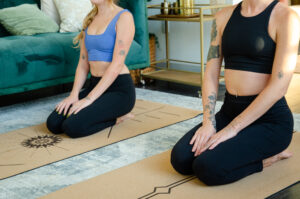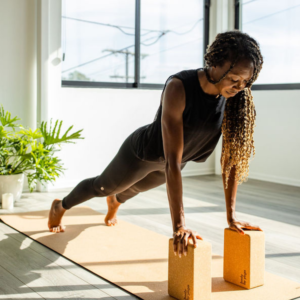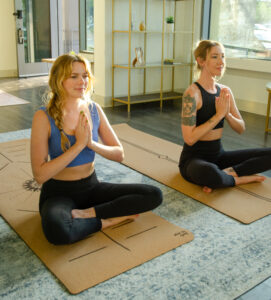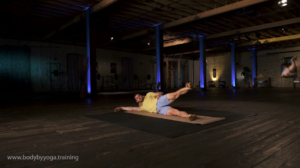20 Minute Yoga for Beginners- Is a 20 Minute Practice Enough Time to Do Yoga?
- Updated on: October 14, 2021
20 Minute Yoga Practice
The typical length of an average yoga class is usually around an hour long in most studios, though lengths may vary to be less (around forty-five minutes) or more (around ninety minutes).
However, did you know that you can have a shorter yoga practice and still have a lot of success? That’s right! You can start off with a shorter length of a class and either continue to practice it on a regular basis, or build your way up to a longer class as time goes on.
While an hour long class is preferred by some, many others do not have the time or patience for a sixty minute class. Longer classes can be very beneficial, but you can also see results in a shorter time period. In fact, shorter classes allow you to practice more often, meaning you might even see more benefits practicing yoga daily for 20 minutes than you would in an hour long class once or twice a week. (Khazan, 2017)
There are a variety of yoga class lengths to pick from. Some people prefer only a few minutes of yoga and some want more than an hour. The truth is, however, that even 20 minutes of yoga can have numerous benefits if you have an ongoing practice.
20 minute yoga for beginners is also a great way to get yourself started with your practice and to work your way up over time. Whether you continue to practice for 20 minutes each time, or even build up to longer classes, doing 20 minutes of yoga for beginners can be great for people of all ages, experience, and abilities.
The Benefits of a 20 Minute Yoga Sequence for Beginners
Did you know that even 20 minutes of yoga can be great for beginners? In fact, 20 minute yoga for beginners can actually have a variety of benefits!
Let’s take a look at some of these benefits to learn how just 20 minutes of yoga can help you!
Starting a Yoga Practice- A 20 minute yoga practice can help you to start a yoga routine, building your way up to doing yoga more often. This is a great way to get your yoga journey going. You might choose to continue doing 20 minute classes, or you might eventually work your way up to hour-long practices. Even a shorter class to begin with can help you to get your body used to doing yoga and to be able to enhance your endurance so that you can practice even more yoga in the long run!
Maintaining a Yoga Practice- Maintaining a yoga practice is not always easy. For some, it can be hard to find time in a busy work schedule to be able to do yoga. In this case, doing shorter, 20-minute classes can be a great way to squeeze yoga into your schedule without taking too much time away from everything else you are doing. A shorter practice is also less intimidating, so for those who are incredibly nervous to begin a practice, doing a 20 minute class might help to relieve some of the anxiety. This can be helpful in maintaining your yoga practice and having enough time to do it.
Stress and Anxiety Relief- 20 minutes of yoga can easily help to feel more relaxed. Through practices of meditation, mindfulness, deep breathing, and stretches, yoga can assist in releasing pent up stress and feeling calmer. If you deal with a lot of anxiety, try including some 20-minute classes in your schedule. 20 minutes is plenty of time to see results without feeling overwhelming. (Ross, et al.)
Feeling Grounded- Being grounded means being fully present in the current moment. When you are feeling all over the place and unfocused, this is the process of being ungrounded. When you are able to bring your full attention to where you are now, your senses, and your present thoughts, you are able to be more grounded. Grounding can also mean feeling more connected to the earth. Yoga can help with this connection and with strengthening mindfulness, assisting in bringing the attention to the present moment and what is happening within it.
Cardiorespiratory Health- Did you know that yoga has a ton of benefits for the cardiorespiratory system? Yoga actually builds up the muscles of both the lungs and the diaphragm through learning breathing techniques. In addition, yoga can help to lower blood pressure and heart rate. Yoga can even improve circulation, increasing proper blood flow throughout the body.
Focus and Concentration- Yoga is also a great way to promote focus and concentration. This is why yoga is now being included in so many school curriculums. The same benefits can be seen in adults who practice yoga. If you struggle with feeling focused during the day, starting a yoga practice might be very beneficial in strengthening your concentration. Even 20 minutes of yoga a day can be great for brain function and focus. (New York Daily News, 2019)

Is 20 Minutes Enough Time to See the Benefits of Yoga?
Believe it or not, 20 minutes of yoga can actually have many benefits. You do not have to do hour-long practices to see results. In 20 minutes, your body is constantly moving and you are using your muscles. When done on an ongoing basis, 20 minutes of yoga can offer many benefits.
Strength Building- Yoga is great for building muscle and strengthening the body. The variety of poses practiced in a yoga class are meant to stretch and strengthen the entire body, even focusing in on some of the less obvious muscles. When you do routines like weight training, it is often the bigger muscles that are targeted. In yoga, the smaller, less-used muscles can be activated and strengthened, even helping you in your other exercises.
Weight Loss- Yoga is a great form of movement that helps to burn fat and calories while building muscle. If you are looking to lose weight, practicing 20 minutes of yoga throughout the week can help you to see results. While yoga does not involve a lot of cardio, you are still up and moving, flowing through the poses, and engaging your muscles.
Endurance- Yoga can help you to build up your endurance. Through holding intense poses, practicing breathing, and learning mindfulness, yoga can increase endurance and make it even easier to exercise in general. If you find yourself struggling through other exercises, and you want to start a yoga practice, you might find that other forms of movement begin to become easier and that you can keep up with them more. In this way, yoga can really help with your endurance and can keep you up and moving.
Energy- Just like with endurance, yoga can also help to keep your energy up. Have you ever woken up and been so exhausted that you feel like you barely slept? If so, trying yoga in the morning might be a great solution for you to get your blood pumping and to focus your mind before a long day at school or work. Yoga can help you to feel more awake, aware, and energized.
Flexibility and Mobility- If you struggle with flexibility and/or mobility, then yoga can definitely be helpful for you. You do not have to already be flexible to do yoga. In fact, yoga is all about understanding your body better and working with your own levels of flexibility to help them increase gradually and safely over time. A yoga practice helps to break down scar tissue from past injuries, decreases tightness of the fascia and tissues of the body, and, in turn, allows you to have more mobility throughout the body.
Balance- Yoga promotes balance through the many balancing poses involved in a practice. Though not every yoga class will include balancing poses, the majority can help you to increase your balance in some form. Yoga keeps the muscles strong and engaged and teaches balancing techniques. Through yoga, you will learn to pick an unmoving line of sight to rest your gaze on, helping with balance. We also use our inner ears and all four corners of the feet to balance. Yoga helps us to become more in tune with our body and strengthen the muscles that help us to stay balanced.
Bone and Joint Health- Did you know that yoga can even strengthen your bones, keeping them dense and sturdy? In addition, yoga can be beneficial for your joints, keeping them mobile and open, and preventing conditions like joint inflammation and arthritis. Yoga also helps to keep the muscles, ligaments, tendons, and other tissues of the body strong and healthy. This ensures that the bones and joints are properly supported and are less likely to become injured. One study even looked into the effects that yoga has on bone density and osteoporosis. The study involved doing only 12 minutes of yoga a day, and the monthly results were examined. Bone density gain was significant in the spine and femur. In addition, for certain patients, the bone density in the hips also increased. These results show that yoga not only helps to prevent loss of bone density and the ongoing effects of osteoporosis, but it can even help to reverse the loss of bone density. Keep in mind that this study only included 12 minutes of yoga a day. Imagine what 20 minutes of yoga daily could do for you! (Lu, et al.)

How Long Should a Yoga Practice Be?
A yoga practice can vary in length depending on the preferred amount of time you would like to spend in each practice. The truth is that every yoga class is unique, and each practice can range from just a few minutes long to even up to ninety minutes or more!
For Building Routines- If you are trying to build a new routine and work your way up to doing more yoga, then you might start off with shorter classes. Doing ten to 20 minute classes can be a great way to get your body used to the movements involved in a yoga practice. Overtime, you can then work your way up to being able to do longer, more intense practices.
For Exercise and Weight Loss- Is yoga your main source of exercise? If you answered yes to this question, then having longer classes can be better to keep your body moving and burning calories. The frequency of your practice should also be taken into account here. If you are only practicing about once or twice a week, then you will want to stick to longer classes that are, at a minimum, thirty to forty minutes. If you can do even longer practices, that is great. If you are practicing about three or four times a week, you are able to try out some shorter practices around 20 minutes long. If you are practicing daily, then you can get away with trying some ten minute routines, however, it is recommended to work your way up to 20 minutes or more for optimal results.
The right length of a yoga class really does depend on each individual person and what their needs are. The best class for you may be totally different from someone else. Listen to yourself, your needs, and the right choices for you.
How Often Should You Practice Yoga for Best Results?
How often you should practice yoga depends on the length of classes you are doing and whether or not yoga is your only exercise in your fitness routine or if it is in addition to other exercises.
As Your Main Source of Exercise- If yoga is your main source of exercise, it is better to do it more often. If you are practicing 20-minute routines, then it is good to do yoga about three or four times a week. If you have shorter yoga classes, then doing yoga more often is important. For ten minute classes, at least five or six days a week of yoga can be helpful. For longer classes, you can space out your practices more. If you are doing forty-five minutes or an hour of yoga each time, then two to three times a week should be very beneficial for you.
In Addition to Other Exercises- If you have a pretty constant workout routine and you are just looking to add yoga to it, then you may not need to practice quite as often. For shorter classes around ten minutes, doing them on rest days or about three times a week should suffice. For 20 minute classes, doing them about two to three times a week, especially on rest days, can be very beneficial. For longer classes that range between forty-five minutes to an hour, yoga should be done about once or twice a week in addition to other exercises in your routine.
Different Class Lengths- If you are only doing ten minute classes, then it is a good idea to do yoga more often. Ten minute classes can be done at least five days a week if not daily depending on whether or not you are having other forms of exercise as well. If you are doing longer practices, then you do not have to do them as often. If your classes are ranging between forty minutes to an hour (or more) you can practice about two times a week (depending on what other exercises you are doing as well.) However, you can feel free to do more if you choose to.
As you can see, the proper length of a yoga practice really depends on the person, but on average, having at least 20 minutes of yoga can have optimal results if done on an ongoing basis. It is better to do shorter practices if you are able to practice more often. The more often you practice, the more benefits you will see. (Ross, et al.)
With class lengths varying, the proper amount to do yoga will be different for each and every individual. It is important to take the proper time to look into what the best length of a yoga practice will be for you and make space in your schedule for it.
How Long are Body By Yoga Classes?
Body By Yoga offers many different yoga classes and programs to choose from. Our classes range in length depending on the specific practice. However, the majority of our classes are about thirty minutes or less since we believe that you do not need a full hour-long practice to have optimal results. In fact, our classes are anywhere from ten minutes to an hour long, so you have a lot to pick from.
While we do offer some longer classes most of our practices will be on the shorter side to allow you to be able to do yoga more often.
Building a new yoga routine can be challenging, but having a variety of practices to choose from can make it so much more accessible.
Best Body By Yoga Programs that are 20 Minutes Long
We offer many practices of different lengths. You can find a lot of classes on our website that are just 20 minutes long! The classes listed below will be just around 20 minutes each. You can read through them to find which 20-minute class would be best for you so that you can get started.
Our Yoga Body Strong program has nine classes, five of which are only 20 minutes! You can check out this program here!
Next you can try our Yoga Boost program. This program involves four beginner yoga workouts, all of which are between 20 to 25 minutes long. You can check out our Yoga Boost program here!
Our Yoga Edge program is designed for athletes. All of the classes in this program are between 20 to 25 minutes. To learn more about this program, click here!
Our Yoga Fix program is for absolute beginners and involves a five day system of 20 minute workouts! This is a great program to get started with that will provide you with five different classes to try out! You can check out this program here! In addition, to try out a free 20 minute Yoga Fix class, click here.
Our Yoga Start class is a beginner’s chair yoga routine. The class is just about 25 minutes long and is great for all levels and abilities. Click here to check it out!
Another class that is just around 25 minutes is our Yoga Sweat 2.0. This class is meant for beginners of power yoga. Want to check this class out? Click here!
Another great program that we offer is Better Back Yoga. This program involves four different practices for alleviating back pain and strengthening the muscles of the back and core. There are four classes included in this program, three of which are 20 minutes long. The fourth class is only ten minutes long. If you want to check our Better Back Yoga program, click here!
Finally, in our Guyoga program, we offer one class that is 20 minutes called Stretch and Destress. Our Guyoga program was created with men in mind, aiming to make yoga more accessible for male bodies. To check out our Guyoga program, click here.
In addition to all of the programs above, we have many lessons of different time lengths that are free on youtube. To check out our awesome youtube channel, please click here!
Reference: Khazan, O. (2017, May 1). Yoga classes should be shorter. The Atlantic. Retrieved October 14, 2021, from https://www.theatlantic.com/health/archive/2017/05/yoga-classes-should-be-shorter/524850/. Lu, Y. H., Rosner, B., Chang, G., & Fishman, L. M. (2016). Twelve-Minute Daily Yoga Regimen Reverses Osteoporotic Bone Loss. Topics in geriatric rehabilitation, 32(2), 81–87. https://doi.org/10.1097/TGR.0000000000000085 New York Daily News. (2019, January 10). Doing yoga for 20 minutes improves focus and brain function: Study. nydailynews.com. Retrieved October 14, 2021, from https://www.nydailynews.com/life-style/health/yoga-20-minutes-boosts-brain-function-study-article-1.1366274. Ross, A., Friedmann, E., Bevans, M., & Thomas, S. (2012). Frequency of yoga practice predicts health: results of a national survey of yoga practitioners. Evidence-based complementary and alternative medicine : eCAM, 2012, 983258. https://doi.org/10.1155/2012/983258
Recent Posts
Categories
Related Articles

Breathing technique to improve your yoga practice

Benefits of yoga before bed

Taking the next step to more challenging yoga

Hatha vs Power yoga
Related Articles

Stretching and Strengthening your hips
In this workout we start slow to warm up your hips. Utilizing low impact workouts like this can be important for beginners and yoga veterans

Hatha vs Power yoga
We’ve created our own unique style of slow burn power yoga that combines Hatha yoga, power yoga, bodyweight exercises and physical therapy. This way in

The importance of maintaining correct alignment
Everything in your body is connected, so when one muscle isnt aligned properly it can be a slippery slope to injury. Building a solid foundation







